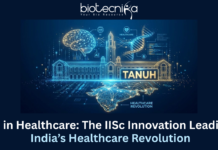What Is Organoid Intelligence? The Future of AI Might Be Biological
What if the future of computing isn’t built with chips and circuits? What if the future of AI lies in living brain cells? From voice assistants to self-driving cars, we are living in an era where AI has effortlessly become part of our lives. But do you know a new frontier is quietly taking shape in biology labs across the world? Yes, you read it right. A new intelligence is preparing itself to battle against the AI, and we call it Organoid Intelligence.
A mind-bending fusion of neuroscience and technology that uses lab-grown brain cells to perform tasks typically reserved for machines. These aren’t science fiction dreams. They’re real, alive, and already learning. In an era where silicon may be reaching its limits, biology might just be the next big leap.
Welcome to a world where computing gets cellular—and the brain in a dish might be smarter than you think.
What Is Organoid Intelligence?
The clusters of human brain cells grown from stem cells are called organoid Intelligence (OI). These cells can perform tasks that are commonly handled by computers. The brain organoids are simplified and miniature models of the human brain. They don’t have the ability to think or feel. But they can learn, process information, and respond to their surroundings.
Using these lab-grown neural cells, scientists create organoids that mimic basic human brain functions. By connecting them to a computer via special electrodes, researchers are teaching these living mini-brains to interact with digital systems.
It sounds like science fiction. But the reality is it’s already happening. And you know what the fun part is. Some of these organoids have even learned to play simple video games. They are responding to feedback and adjusting their behavior just like a living brain would.
Why Should We Pay Attention?
You may wonder how this innovation relates to you or what importance it holds in your daily life. Let me explain. The reason is simple. This tiny organoid is challenging our very understanding about computing. We all know that, despite their power, traditional computers have their limitations. Their architecture and energy consumption limits them.
Whereas, the human brain is remarkably efficient. It runs on just 20 watts and can outperform supercomputers in pattern recognition, learning, and creativity. Here is what organiod intelligence brings to the table:
- Higher learning efficiency
- Ultra-low power consumption
- Better disease modeling and drug testing
- Adaptive computing platforms that mimic biological learning
It’s not just about faster machines anymore. Now it’s all about smarter, more human-like systems that can learn and adapt.
What Can These “Mini-Brains” Do Today?
Eventhough OI is still in its early stages, its capabilities are already impressive. Currently, it can:
- Learning simple games through trial and error
- Responding to electrical stimulation
- Simulating neural activity seen in human brains
- Modeling diseases like epilepsy or Alzheimer’s
They are not capable of programming or running complex tasks yet. But the researchers believe these tiny bio-systems will play key roles in decision making, learning, and even working alongside AI in hybrid platforms one day.
Brain Cells vs. Silicon Chips
The brain cells or neurons communicate through billions of dynamic connections known as synapses. These changes and strengths come with experience. And this process is known as neuroplasticity.
Whereas, on the other hand, silicon chips require fixed code and massive amounts of training data to perform tasks. They consume more energy and lack flexibility when compared to the human brain. These don’t have an adaptive nature like a biological brain.
A small organoid might learn more efficiently and consume only a fraction of the energy. This makes it a powerful alternative in an age of rising energy costs and slowing chip innovation.
Walking the Ethical Tightrope
With great power comes great responsibility and serious questions. OI is raising deep ethical concerns due to its dependence on human-derived brain cells. These organoids are not conscious or self-aware. This leads to questions like
- Could they ever experience pain or awareness?
- Do they deserve any form of rights or protection?
- How do we ensure we don’t cross ethical boundaries?
Scientists and bioethicists are already working on establishing a responsible framework. They are focusing on transparency, medical advancement, and humane research practice. However, as we know, these systems become increasingly complex. Society will need to re-examine the line between curiosity and exploitation continually.
What’s Next for Organoid Intelligence?
We won’t be replacing cloud servers with dishes of neurons just yet. But researchers are already imagining near-future applications, including:
- Hybrid systems combining brain organoids with AI algorithms
- Biological co-processors to support simulations and adaptive computing
- Disease models for faster and safer drug testing
- Brain-like learning systems in robotics and autonomous machines
Think of it not as replacing traditional chips, but as adding a new tool to the computing toolkit—a biological one that complements what machines can’t do alone.
A New Era in the Making
The microchip revolution changed everything. Organoid intelligence could spark the next one. This is not just about machines doing things faster, but about machines that learn more like us, solve problems with biological creativity, and adapt to new challenges in real-time.
Whether you’re in tech, healthcare, or simply a curious observer of science, Organoid Intelligence is a field worth watching. It invites us to rethink what intelligence is, how it can be built, and where the future of computing might be headed.
Right now, it’s just a brain cell learning a game in a petri dish. Tomorrow, it might be part of the system helping humanity solve its biggest challenges—from climate change to cancer.
This is not just the evolution of technology.
It’s the beginning of a new biology-driven age of intelligence.























